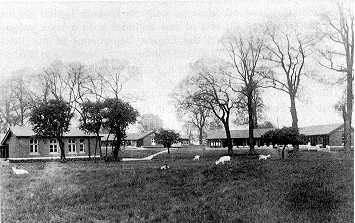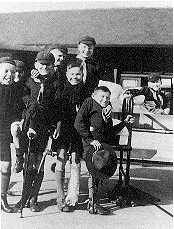1930 - 1940
This was the period of expansion for the sanatorium. All is best recorded in the text of the actual brochure produced by the Bristol Corporation to celebrate the opening of the new buildings, the actual ceremony being carried out by Sir George Newman, KCB, MD, on Wednesday 17th June 1931. A copy of the original brochure is in the City Archives and also, fortunately, in the Post Graduate Centre library in the hospital. It is illustrated with plans and photographs, including one of the house. There are various chapters which go as follows:
1. FRENCHAY PARK SANATORIUM
General Medical Superintendent:
DR. R. H. PARRY, Medical Officer of Health
Consulting Orthopaedic Surgeon:
G. R. GIRDLESTONE, Esq., F.R.C.S. (Eng.)
Surgeon:
H. CHITTY, Esq, MS (Lond.) F.R.C.S. (Eng)
Consulting Radiologist:
T. B. WANSBROUGH, M.B., Ch.B.
Tuberculosis Officer:
DR. C. J. CAMPBELL FAILL
Assistant Tuberculosis Officer:
DR. J. SCOTT CURRIE
Resident Medical Superintendent:
K. H. PRIDIE, Esq., M.B., B.S.(Lond.), F.R.C.S. (Eng.)
Matron:
MISS L. ALLEN
2. NOTES BY THE GENERAL MEDICAL SUPERINTENDENT
The duty of dealing with tuberculous disease was laid upon the Health Committee by the National Insurance Act, 1911, which came into force in 1912, and the Health Committee, as soon as practicable after the war, proceeded with their tuberculosis scheme. In 1921, with the approval of the Ministry of Health, they purchased Frenchay Park, with 70 acres (approx.) of land, for the special purpose of devoting it to the treatment of all forms of tuberculosis in children.
Immediate accommodation was provided for 35 patients, and it was the intention of the Committee as soon as possible to extend the accommodation to 100 beds. This development, however, has been unavoidably delayed, but is now complete. Frenchay lies on sandstone rock formation, giving a very dry and warm subsoil. The sanatorium is situated six miles from the centre of the city, from which it is separated by a broad belt of open country. The estate is sufficiently large to prevent near encroachment on the hospital by any future building.
The success of treatment of tuberculosis very largely depends upon early ascertainment of the cases and their early subjection to treatment. When beds have to be sought for at institutions outside the city delay frequently has resulted, but it is hoped that this will now be obviated.
The success of treatment at any institution is enhanced by good 'team-work.' The Health Committee has had this aspect under serious consideration in preparing the scheme. Whilst about half of the cases admitted into this institution will be of the 'surgical' type, the majority of these will require orthopaedic treatment. The Committee therefore decided to bring this institution into their orthopaedic scheme for the city.
In 1929, Mr G. R. Girdlestone was appointed consulting orthopaedic surgeon to the city, in an advisory capacity. Mr H. Chitty, who has been responsible for the city's orthopaedic work for some years has been appointed visiting surgeon to the hospital, and his appointment has also been extended to include that of visiting orthopaedic surgeon to Southmead Municipal Hospital, where he will be working in conjunction with Mr Hey Groves. Mr K. H. Pridie - the resident superintendent at Frenchay Park - will also act as assistant orthopaedic surgeon to Southmead Hospital. This 'orthopaedic team' will have the co-operation of Dr C. J. Campbell Faill, tuberculosis officer, in all matters relative to tuberculosis.
The estate includes a farm, from which the institution derives the benefit of fresh produce. The farm supplies the sanatorium with milk of high standard, and the Farms and Gardens Sub-Committee of the Health Committee are determined to obtain and maintain a fine herd of milking cows free from tuberculosis. In addition, a number of goats are kept, and fresh eggs are obtained from poultry on the farm. About six acres (including a kitchen garden of about 3 acres) are kept under cultivation to supply the requirements of the institution. Fresh vegetables are supplied daily to the institution. The conditions for fruit production in the grounds are excellent; at present the supply is limited and fruit growing on the estate could with advantage be further developed.
[I was reminded in November 1995 that not all "farming" had ceased on the hospital site. For many years the walled garden at the NE edge of the estate behind the "forest" had been, and still is, used as allotment plots for members of staff.]3. NOTES BY THE TUBERCULOSIS OFFICER
It is now known that over 90 percent of the whole population is infected by the tubercle bacillus by the time they reach the age of 18 years. The number of those infected has been shown to be very small in the first years of life, and to increase steadily, till the figure of 90 percent is reached at about 18 years. It would appear that this childhood infection, if successfully resisted as it is in the majority of us, confers a lasting immunity to the disease. It must also be remembered that infection is not necessarily followed by disease. There are, however, a large number of children, who, either from a lack of resistance due to a variety, of causes, or to an overdose of tubercle bacilli, develop symptoms of disease. If these are recognised and treated promptly a lasting immunity is conferred. Thus such an institution as Frenchay Park, as well as preventing unnecessary suffering, and in some cases permanent crippling, is a sound economic proposition.
Cases in which lymphatic glands and the peritoneum (the lining membrane of the abdomen) are involved are usually most amenable to treatment, and in the great majority complete disappearance of all signs and symptoms is to be expected. Cases in which bones and joints are affected, also respond to treatment very well, and in 80per cent complete cure is to be expected with no impairment of function. The cases in which the spine or hip is affected require prolonged treatment, and in young children a tubercular spine is especially prone to relapse. The third class of case is that in which there is actual invasion and, possibly, even destruction of lung tissue. These are fortunately relatively uncommon, although not quite so rare as some people imagine. They are always serious, but not necessarily hopeless, and invariably require very prolonged treatment, even up to two years.
4. TREATMENT
No matter what tissue or organ may show signs of involvement, tuberculosis must always be considered and treated as a general disease. It has been demonstrated experimentally that at some time or other in the course of every tubercular infection living tubercle bacilli circulate in the blood. In fact it is difficult to see how the tubercle bacilli can reach a spinal vertebra or a hip joint unless carried there in the blood stream. What may be called' general sanatorium treatment' is the bedrock on which to build.General Sanatorium Treatment implies:
(a) Rest. Absolute rest, both physically and mentally until all general symptoms have disappeared - that is, till the temperature remains normal morning and evening, the pulse settles down and becomes permanently, slower, and the appetite returns.
(b) Fresh air. The whole institution is designed to give the patients the maximum of pure fresh air in all weathers, and at all seasons of the year.
(c) Diet. This is of great importance, as these children suffering from a wasting disease must also keep up their normal growth. The diet must be full, but also varied and palatable. Faddiness is firmly discouraged, but to force unwanted food down an unwilling throat is worse than useless. As much fresh food as possible must be given, and much of this can be obtained direct from the farm at Frenchay. Another very important point is extreme regularity. Meals are served punctually, at the same time each day, and nothing is eaten between meals.
Special Treatment
(a) Heliotherapy, or treatment by exposure to direct sunlight. This is carried out on the lines elaborated by Sir Henry Gauvain at Alton and Rollier at Leysin in Switzerland. It is a most valuable method of treatment, but entails a great deal of work for the nursing staff.
(b) Artificial sunlight. This as a rule is not necessary at Frenchay in summer when there is ample natural sun, but during the winter months it becomes essential. At present we have two large carbon-arc lamps for general irradiation, and one tungsten-arc for local treatment. Provision has also been made for adding to the battery of lamps as necessary.
(c) Tuberculin either injected or made into an ointment and rubbed into the skin is of value in certain cases, more especially abdominal.
(d) Artificial Pneumothorax has proved its value in pulmonary tuberculosis in children as in adults. It is only applicable to certain selected cases, but in these gives remarkably good results.
(e) Bone and joint cases. If a case of tuberculosis of a bone or joint is discovered in an early stage, actual operation is rarely necessary. The aim of the surgeon is to ensure that the patient regains complete functional efficiency, without deformity. This last is a great deal more difficult than might at first appear, as these cases all differ greatly, and although no actual cutting operation is undertaken, a successful result demands endless patience, much ingenuity, and the very highest degree of professional and technical skill.
Much has been heard in England since the war of the necessity of 'teamwork.' An institution such as Frenchay Park should be a living example of 'team work' at its best physician, surgeon, diet expert, educationalist, all working together to one end - the eventual discharge home of happy, healthy, educated children. Although much is known of tuberculosis, a great many problems remain to be solved, and it is to be hoped that in the future Frenchay Park may make its contribution to the sum of our knowledge of this infection.
5. REPORT BY THE CITY ENGINEER. LESSEL S. McKENZIE, Esq., M.I.C.E.
The scheme for the erection of a 100-bed sanatorium which was prepared and carried out in two sections, commenced in November, 1928. The first portion of the scheme, completed at the end of April, 1930, comprised the erection of two ward pavilions, each containing 44 beds, an observation pavilion, containing 12 beds, a treatment block, a school for 30 children, and the necessary drainage, water supply, electric cables, fencing, roads and paths. The second portion of the scheme was the conversion of the mansion house, which was first used as the sanatorium, into an administrative building, with accommodation for a resident medical officer, matron, six sisters, twenty-one nurses, and twelve maids. Extensive alterations and additions were made, including new wings on the ground floor, first floor and second floor. This work commenced in August, 1930, and was completed at the end of April, 1931.
The scheme necessitated carrying a 9 inch sewer from the city boundary in Beech Hill up the road for a distance of about 35 yards to the south-west corner of the estate, and across the grounds in an easterly direction for about 520 yards, thence in a northerly direction for about 75 yards, to a point between the two ward pavilions. Branches were then carried to each building, and to the new administration building. A 3 inch water main is carried from the new administration building with branches to each building. An electric cable from the Bristol main supply is carried from the new administration building and branches taken in to each building.
The pavilions, treatment block and school are erected in the grounds to the north of the administration building. They are all one storey high, and have been designed and built to harmonize with each other in brickwork, with Cattybrook red facing bricks, and Bath Stone dressings. All the buildings have boarded roofs, felted and covered with Broseley tiles, and the gables are treated with half timber work.
The external walls are built hollow with 4 inch inner and outer walls, and a two inch cavity, the walls being tied together with galvanized iron wall ties, except the walls of the treatment block, which are of 14 inch brickwork. The internal walls and ceilings are plastered with granite plaster, except where otherwise stated in the descriptions which follow of the various buildings. All windows are casement windows opening outwards, with fanlights over falling inwards, except the large window in the operating theatre, which is fitted with Austral sashes.
All the buildings including the administration block are heated throughout by hot water radiators and pipes, except the school which is heated by an anthracite stove.
6. WARD PAVILIONSEach block affords accommodation for 44 patients. The blocks have been designed on the 'Y' shaped plan, with the front of the wards facing south. The walls of the bathrooms, shower bathrooms, sink rooms and lavatories in sanitary blocks are faced with white Vitrolite to a height of 4ft. 6ins. above skirting. Tile foundation of the floors are formed of cement concrete. The floors of wards and nurses' duty rooms are laid with polished maple flooring, in narrow widths, and the floor of ward kitchen of 6ins. by 6ins. Ruabon pressed red tiles.
The floors of the drying rooms, clothes stores, linen rooms, pantries and stores are laid with Linolith jointless flooring, and the remaining floors with Terrazzo paving.
The east and west wings of each block have a ward, size 42ft. by 20ft., containing 14 beds, with two separate wards at the end, size 11ft.9ins. by 20ft., containing 4 beds. The front of these wards face south, and have doors opening direct on to an open balcony, thus affording facility for patients' beds to be moved out in suitable weather. These balconies run the whole length of the buildings, are 14ft. wide, and are formed of cement concrete paving with a cement concrete dwarf wall in front.
In the centre of the building is the nurses' duty room, with ward kitchen behind. The ward kitchen has a wash-up sink, dresser, cupboard and a small cooking range. The duty room is so situated that complete observation is obtained over the wards.
Each pavilion has two sanitary blocks to the north of the main building, containing bathroom, shower bath-room, lavatory, sink room, clothes stores, linen rooms, drying room, and the necessary water closet accommodation for patients and staff.
The boiler house and coal stores are provided in the basement of each pavilion.
1930s. Ward Pavilions and Observation Pavilion (on the left). Note the beds outside the wards and the livestock grazing around the grounds
7. OBSERVATION PAVILION
This block built on the 'E' shaped plan with the front of the wards facing south contains 12 wards of the single bed type. The walls of bathrooms and sink rooms are faced with white Vitrolite to a height of 4ft. 6ins. above coved skirting.
The floors of wards are laid with polished maple flooring in narrow widths, and the floor of nurses' duty room of 6ins. by 6ins. Ruabon red tiles. The floors of bathrooms, sink rooms and staff lavatory are laid with Terrazzo paving.
The twelve wards in this pavilion, each measuring 10ft. by 8ft. open out on to a cement concrete paved and covered veranda, 5ft. 6ins. in width, running along the whole front of building. In the centre of the building is the nurses' duty room, with staff lavatory accommodation, pantry, and linen room at the back. The duty room has a wash-up sink, dresser, and a small cooking range. In each angle of the building is a bathroom, sink room and water closet. The boiler house and coal store are provided in the basement.
8. TREATMENT BLOCKThe building is situated to the north of the two ward pavilions, and centrally, between them.
The walls of the laboratory, dispensary and shower bathroom are lined with white Vitrolite, to a height of 4ft 6ins. above top of skirting, and the walls of operating theatre and sterilising room for their full height.
The foundations of the floors are formed of cement concrete. The floors of light treatment room, anaesthetic room, X-ray room, dark room, store and corridors are laid with polished Bagac flooring in narrow widths. The floors of porch, operating theatre, sterilizing room, shower bathroom and lavatories are laid with Terrazzo paving. All the other floors are laid with 6ins. by 6ins. Ruabon red tiles.
The rooms in this building open off a corridor running east and west of the building. In the centre opposite the entrance is the operating theatre, size 17ft. by 16ft. On the left of the theatre is the anaesthetic room, size 13ft. by 12ft., and on the right is the sterilizing room, size 13ft. by 9ft. 6ins. The latter room contains a surgeon's sink and two wash-up sinks. The anaesthetic room, theatre and corridor are connected by double swing doors, and the theatre and sterilizing room by a wide opening.
At the west end of the building is the light treatment room, size 25ft. by 16ft., approached from the corridor by double swing doors. The windows in the room are glazed with Vita glass, and are fitted with Austral sashes, which enable the lights to be adjusted for ventilation as may be required.
On the left of the main entrance is the dispensary and laboratory, the former having one sink, and the latter two sinks. On the right of the main entrance is the plaster room, size 22ft. 6ins. by 10ft., with double swing doors. This room has a wash-up sink and a lavatory basin. Opening off this room is the drying room, and off the latter the splint room. The plaster room and splint room each have benches with teak tops and cupboards underneath.
The X-ray room, size 16ft. by 13ft., is on the north side of building, and has a dark room attached, fitted with a bench, cupboards and wash-up sink.
Two shower baths are provided in the shower bathroom, and the necessary lavatory accommodation for patients and staff is provided. The boiler house and coal stores are provided in the basement.
9. SCHOOLAt the northeast corner of the lay-out a school for 30 children is built.
The foundations of the floors are formed of cement concrete. The floor of classroom is laid with asphalt, that of teachers room with Linolith jointless flooring, and the floors of lavatories with Terrazzo paving.
The open-air classroom, size 28ft. by 17ft., will accommodate 30 scholars, and is surrounded with a dwarf wall, 2ft. 6ins. high, pierced with four doorways. The roof is carried by wood posts, resting on the dwarf walls. Opening off the classroom is the teachers' room, size 12ft. 6ins. by 12ft., heated by a small register grate. The necessary lavatory accommodation is provided for teachers, boys and girls separately, at the rear of the building.
The building is surrounded by a cement concrete paved footway 4ft. wide, finished with a pennant kerb.
10. ADMINISTRATION BUILDINGThe administration building, formerly the Mansion House - a fine Georgian building - comprises the following accommodation, viz:
Ground Floor
The main entrance through the vestibule leads to a large Georgian entrance hall, with panelled walls and a fine old staircase. On the right of the hall is the office for the medical officer, with panelled walls, size about 17ft. square.
The patients' cloakroom is reached from the entrance hall through the inner hall. This room has a fine ceiling light, with coloured glass, and a staircase leading to the medical officer's private quarters on the first floor. Adjoining the patients' cloakroom is the maids' dining hall, size about 24ft. by 18ft., lighted by a lantern light. At the back of the patients' cloak room is the matron's office.
The east wing comprises the nurses' sitting room, approached from the inner hall, and the patients' dining hall, size about 34ft. by 24ft., a room with a fine cornice and panelled ceiling.
The west wing comprises the nurses' dining hall, maids' sitting room, lavatory, accommodation for visiting committees, nurses and maids.
Behind these rooms are the staff pantry, a staircase leading to the second floor, the kitchen and the patients' pantry.
The scullery, larders, stores, etc., are to the north-west of the kitchen.
First FloorOff the main staircase are 2 bedrooms for sisters, the matron's private quarters, 2 bathrooms and 2 water closets. The east wing comprises the sisters' sitting room in the front, 2 bedrooms for sisters, 1 bedroom for 2 nurses, and private quarters for the medical officer at the north end, consisting of a sitting room, bedroom and bathroom.
The north wing which is an addition, contains 4 bedrooms for nurses, and a bathroom.
The west wing contains 2 bedrooms for sisters, 3 bedrooms for nurses, linen rooms, sewing rooms, 2 water closets, and a housemaid's closet.
Second FloorOff the main staircase are 5 bedrooms for nurses, and a bathroom. The west wing which is an addition, contains 8 bedrooms for maids, 2 water closets, linen room, bathroom and housemaid's closet.
Third FloorAt the top of the main staircase are 4 bedrooms for nurses, and a bathroom.
All the bedrooms for sisters, nurses and maids, and all bathrooms have a lavatory basin.
The boiler house and coal store is in the basement.
The cooking apparatus is steam heated, with the exception of the cooking range, and comprises the following, viz:Kitchen
A large central coal-fired range, size 6ft. by 4ft. 6ins., with four ovens. Two steam jacketed boiling pans, each with a capacity of 20 gallons. One wet steam oven with three compartments. One steam heated carving table, and hot closet, size 5ft. by2ft. 6ins. One steam heated copper water boiler, with a capacity of 5 gallons.
Scullery, Patients' Pantry and Staff PantryOne galvanized iron pot sink with steam boiling nozzle in each room.
The steam boiler for the foregoing fittings has been installed in an outbuilding near the scullery.
MortuaryThe mortuary buildings have been provided in the outbuildings and comprise a mortuary, containing two slate slabs and a table, and a post mortem room, containing slate slab, wash-up sink and lavatory basin, with a lavatory containing wash-up sink.
The designs for the sanatorium and the administration building were prepared in the office of the City Engineer, and the erecting of the buildings has been carried out under the personal supervision of Mr H. W. Harding, L.R.I.B.A., architect.
Mr W. J. Taylor was the clerk of works for both contracts.
The quantities for the two building contracts were taken out by Messrs. W. L. Bernard & Sons, 26 Orchard Street, Bristol.
The contractors and sub-contractors engaged in the erection of the buildings are as follows:
General Contractors
Sanatorium Buildings. Messrs. Coles Bros., Ltd., 22 New Bond St., Bath
Administration Building. Messrs. R. Wilkins & Sons ltd., 85 Bishop Street, St. Paul's, Bristol
Heating
Sanatorium Buildings and Messrs. Arthur Scull & Sons Ltd., Administration Building 135 Redcliff Street, Bristol
Steelwork
Administration Building Messrs. Stock & Collins, Victoria Road, St. Philip's, Bristol
Electric Light
Sanatorium Buildings and The Corporation Electricity Department Administration Building
Cooking Apparatus
Administration Building. Messrs. Arthur Scull & Sons, Ltd., 135 Redcliff Street, Bristol
Sanitary Fittings
Sanatorium Buildings and Administration Building. Messrs. Rowe Bros. & Co., Ltd. City Lead Works, Canons Marsh, Bristol
By the 1990s, the 1931 buildings had changed function
somewhat. The 'pavilion wards' became wards 29 and 30 which had been
considerably added to in the interval; the 'treatment block' became
part of the plastic surgery theatre complex; the 'observation pavilion'
became Occupational Health and the school the Laser Centre.
As indicated above, the house then reverted to a residential and
administrative role, the latter maintained to the time of writing in
1994.
Photographs of the hospital at this time vividly illustrate the
activities; ward pavilion windows were kept wide open, often in
freezing weather; children ran naked in the summer; the school
functioned with many pupils and the farm supplied food. Such was the
range of food produced that examination of the aerial photograph taken
in about 1938 which hangs in the entrance lobby of the Trust H.Q. shows
grazing sheep in quite good numbers.
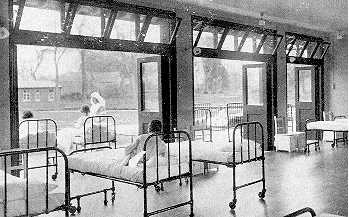
Ward pavilion windows wide open and beds outside.
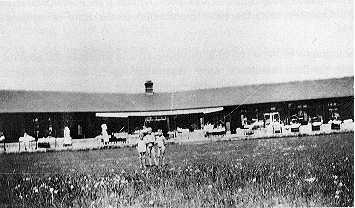
Children naked in the sun in front of one of the wards. The original photo was out of focus but the picture has been included because of its atmospheric nature.
As well as nursing, medical and administrative staff, the sanatorium required other people to keep it and its facilities running. The farm bailiff, Mr Abbott, lived in the Entrance Lodge, what is now known as CLIC cottage. Mr Mustoe, the head gardener lived in West Lodge at the top of the Lime Tree Drive. Sam Caseley, the sanatorium engineer, lived in a third, North, Lodge, which was later used as Matron's cottage by Vera Wilson and then demolished in the 1980s to make way for the new CSSD (Central Sterile Supply Department). He had two sons John and Tom. Another gardener was appointed to help Mr Mustoe; this was Reg Wallace and they were both alive in the early1990s. Reg was interviewed in April 1973 by the Editor of the then current hospital newsletter called 'The Grapevine'. Reg's memories, although not quite exact, make interesting reading:
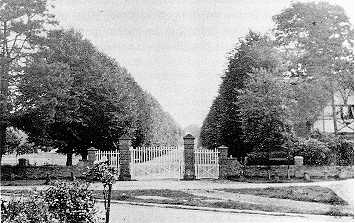
Lime Tree Drive entrance, circa 1938. West Lodge just off right.
OLDEST INHABITANT INTERVIEWED BY STAFF REPORTER. EXCLUSIVE TO THE GRAPE VINE!
Have you ever wondered what the estate of Frenchay Hospital was like before we all arrived here to do our thing? Before the house at the end of the avenue was the Sisters House? There is at least one of us who can remember quite a lot - Mr Reg Wallace, who keeps the grounds looking so attractive, can remember the time before the whole place was cluttered up with the present mish-mash of nissen huts, brick bungalows and other assets of doubtful aesthetic value. Indeed, to Mr Wallace they must be bigger eyesores than to most of us for he can remember the whole estate as one large garden or park.
'Frenchay Park' goes back to 1865. Before that it was just the Big House on Frenchay Common. Successive owners acquired more and more common land by enclosure and, imitating the nobility, turned it into a 'gentleman's country house' standing in its own parkland. It was one William Tanner who brought it to its present size in 1864, and Mr Wallace can almost carry on from there, because he can remember Mr Tanner's heirs selling the house in 1916 to the Cosmos Engineering Company who in turn soon sold it to the Bristol Corporation. Let Mr Wallace carry on from there:
Q. What are your earliest recollections about the hospital?
A. It use to be a private house, with carriage and pair, owned by people by the name of Tanner, until a private firm bought it from them. After a year or two it was then sold to the Corporation in about 1923/24. I came about three four years later as a gardener.
Q. How many staff were there at the time?
A. Just Matron, a sister, two nurses and a maid.
Q. What sort of patients were admitted?
A. About 2 dozen TB bones. The patients had a lot of outdoor treatment. There were no wards, just the big house, and the patients had their meals under the cedar tree whenever possible.
Q. What else do you remember about the hospital at that time?
A. There was a lily pond at the back of the house, near to where Ward 29 is now . This was filled in when the Orthopaedic Hospital for children was builtin 1929/30. (It was opened by the Chief Medical Officer of the Ministry of Health in 1931- Ed.)
Q. When the Corporation first opened the hospital, who ran it?
A. The Health Department at Princes Street.
Q. You came as a gardener - had you had any previous experience as a gardener?
A. I had worked with the local Smithy, shoeing horses and doing a small amount of gardening. At first I was engaged for only one day a week, but after a time I was taken on a weekly basis.
Q. Is there anything else you can remember?
A. I can remember the Lime Tree Drive was cobbled with white stone, and we used to sweep it once a week with besom brooms. When the sanatorium was built it was covered with tarmac, but the cobbles are still underneath. In the early days of the war a low raider mistook us for the aerodrome at Filton and dropped a bomb but it only hit a chicken coop. Incendiaries fell all around the grounds and I used to help to take the children into the shelters. By that time there were three new blocks, opened in 1930, but the rest of the estate was just open grassland.
Q. Well Reg, I think we may say you have successfully completed your probationary period. Almost certainly we shall want you more than one day a week. Would you like to join the permanent staff?
A. (Unprintable! - Ed.)
Some of the hospital wolf cub pack around 1936.
[Mr Cecil Hook made contact in Feb 1995. He, now aged 82, had been a Rover scout in the 1930s. His Scout leader, also still alive in 1995, aged 95, had instructed some of the Rover Scouts to visit one of the patients in the Sanatorium. This patient, Jimmy, never had any visitors. Jimmy is seen in the photo as the young boy with marked deformity holding the Scout hat. The hat probably belonged to Mr Hook. The Scouts visited every Sunday and even persuaded some Guides to also visit some of the girl patients. In this way the Frenchay cub and other packs were formed. Jimmy, aged about 14 at the time of the photo, died of his TB in the early part of the War.]
Matron Allen's car in the 1930s. The face just visible in the rear door window is Violet Hallet, Matron's maid.
Things were not all well with the rest of the World,
however. Storm clouds of war were on the horizon and the Corporation of
Bristol became worried about the lack of hospital beds to accommodate
the expected air raid casualties, should War come. As a result, in
about 1938, plans started to be prepared for the construction of an
Emergency Medical Services hospital. The Frenchay sanatorium site was
chosen as the place for building to take place. Several large pilot
holes were dug along the general line of the front of what we now know
as the front ramp wards. Tom Caseley, who says he used to crawl around
the duct work of the E.M.S. hospital and knew it 'like the back of his
hand' told me that, after the holes were dug, work then stopped for
months.
Eventually a row of wards and associated facilities were started and
mainly finished by early 1942. These facilities consisted of: 15 Wards,
1 Isolation Ward, 1 Twin Operating Theatre, 1 Carpentry and handicraft
section, 1 Gymnasium and physiotherapy ward, 1 Laboratory, 1 Pharmacy,
1 Receiving and evacuation ward, 1 Administration building, 1 Kitchen,
1 Patients' dining room, 2 Stores, 1 Water Tower, 1 Boiler House, 1
Mortuary, 1 Decontamination ward, 1 Garage, 1 Ether Stores, 4 Nurses'
Quarters, 2 Nurses' Wash Areas, 2 Senior Officers' Quarters, 1 Guard
Hut, 15 Air Raid Shelters, 1 Nurses' Mess and Recreation Room.
The children continued to be looked after in their own 1931 wards,
although pictures taken in 1940 or so show the ward pavilions to be
heavily sandbagged. The children stayed until 1947, when they were
transferred elsewhere. The E.M.S. hospital stayed empty until the U.S.
entered the War. In 1942 they were given the empty buildings as a form
of reverse Lease-Lend. The first of the Americans arrived in mid 1942.
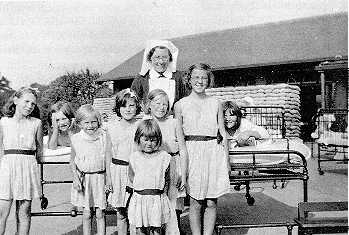
Sister Hunt and patients in 1940 in front of one of the sandbagged wards.
[This photo, along with several others not included in the book, came from Mrs Crang. She had been a teacher at the hospital school at the time and for some period after. In early 1996, when she was 91, she fell and fractured her ankle. She died peacefully in Frenchay hospital in early February.]
